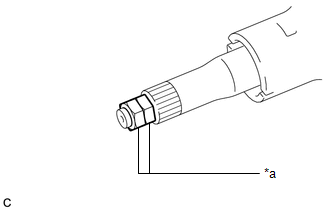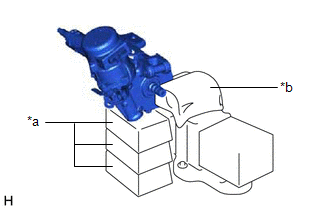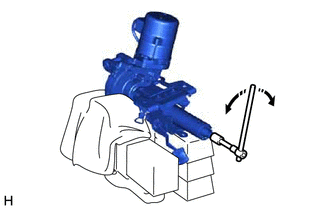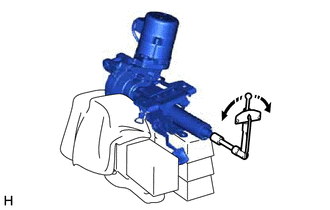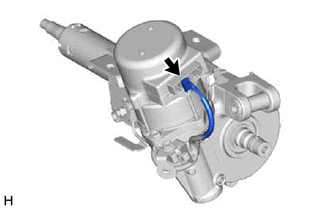Toyota CH-R Service Manual: Installation
INSTALLATION
PROCEDURE
1. INSTALL ELECTRIC POWER STEERING MOTOR SHAFT DAMPER
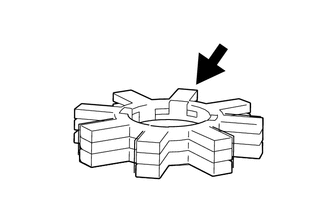
.png) |
Grease |
(a) Apply grease to a new electric power steering motor shaft damper.
NOTICE:
First wipe off the existing grease from the serrated part, and then apply the dedicated grease supplied with a new power steering ECU assembly or electric power steering column sub-assembly.
(b) Install the electric power steering motor shaft damper to the electric power steering column sub-assembly.
2. INSTALL POWER STEERING ECU ASSEMBLY
NOTICE:
- Do not drop the power steering ECU assembly, strike it with tools or subject it to impacts.
- If the power steering ECU assembly is subjected to an impact, replace it with a new one.
- Do not pull the wire harness of the electric power steering column sub-assembly.
- Do not allow any moisture to come into contact with the power steering ECU assembly.
- Do not loosen any bolts not mentioned in the procedure.
- Do not allow any foreign matter to contaminate the power steering ECU assembly.
(a) for Type A:
(1) Using a T40 "TORX" socket wrench, temporarily install the power steering ECU assembly to the electric power steering column subassembly with the 2 screws.
NOTICE:
When temporarily installing the 2 screws to the power steering ECU assembly, do not tighten them all the way down.
(b) for Type B:
(1) Temporarily install the power steering ECU assembly to the electric power steering column sub-assembly with the 2 bolts.
NOTICE:
When temporarily installing the 2 bolts to the power steering ECU assembly, do not tighten them all the way down.
|
(c) Install 2 service nuts to the steering main shaft. Recommended Service Nut: Thread Diameter 12.0 mm (0.472 in.) Thread Pitch 1.25 mm (0.0492 in.) |
|
(d) Simultaneously rotate the service nut that was installed first counterclockwise and rotate the service nut that was installed second clockwise to lock them.
NOTICE:
Do not apply excessive torque to the service nuts by using a tool such as an impact wrench.
HINT:
The service nuts are used for turning the steering main shaft during inspection of the steering main shaft rotating torque.
Remove the service nuts after performing this inspection.
|
(e) Secure the steering column assembly in a vise using aluminum plates, cloths and wooden blocks. NOTICE:
|
|
|
(f) Rotate the steering main shaft 180 degrees counterclockwise and then 180 degrees clockwise at a speed of 60 rpm, and repeat 2 to 3 times to center the axis of the power steering ECU assembly. [*1] |
|
(g) for Type A:
(1) Using a T40 "TORX" socket wrench, tighten the 2 screws. [*2]
Torque:
18.5 N·m {189 kgf·cm, 14 ft·lbf}
(h) for Type B:
(1) Tighten the 2 bolts. [*2]
Torque:
18.5 N·m {189 kgf·cm, 14 ft·lbf}
|
(i) Using a torque wrench, measure the turning torque of the steering main shaft. Preload: 1.2 to 2.4 N*m (13 to 24 kgf*cm, 11 to 21 in.*lbf) NOTICE: Ensure that there is no abnormal resistance during rotation. If the turning torque is not as specified, loosen the 2 bolts and repeat steps [*1] and [*2] to recenter the axis of the power steering ECU assembly. |
|
(j) Remove the 2 service nuts.
|
(k) Connect the connector. |
|
3. INSTALL STEERING COLUMN ASSEMBLY
Click here
.gif)
4. TORQUE SENSOR ZERO POINT CALIBRATION
Click here
.gif)
5. ASSIST MAP WRITING
Click here
.gif)
 Components
Components
COMPONENTS
ILLUSTRATION
*1
ELECTRIC POWER STEERING MOTOR SHAFT DAMPER
*2
POWER STEERING ECU ASSEMBLY
*3
ELECTRIC POWER STEER ...
 Removal
Removal
REMOVAL
CAUTION / NOTICE / HINT
The necessary procedures (adjustment, calibration, initialization, or registration)
that must be performed after parts are removed, installed, or replaced during th ...
Other materials:
Toyota CH-R Service Manual > Automatic High Beam System: Diagnostic Trouble Code Chart
DIAGNOSTIC TROUBLE CODE CHART
Automatic High Beam System
DTC No.
Detection Item
Link
B124B
Automatic High Beam System
B124C
Automatic High Beam Camera
U ...
Toyota CH-R Service Manual > Cellular Communication: Telephone Microphone
Components
COMPONENTS
ILLUSTRATION
*1
TELEPHONE MICROPHONE ASSEMBLY (MAP LIGHT ASSEMBLY)
-
-
Removal
REMOVAL
PROCEDURE
1. REMOVE TELEPHONE MICROPHONE ASSEMBLY (MAP LIGHT ASSEMBLY)
Click here
Installation
INSTALLATION
PROCEDU ...
Toyota C-HR (AX20) 2023-2025 Owner's Manual
Toyota CH-R Owners Manual
- For safety and security
- Instrument cluster
- Operation of each component
- Driving
- Interior features
- Maintenance and care
- When trouble arises
- Vehicle specifications
- For owners
Toyota CH-R Service Manual
- Introduction
- Maintenance
- Audio / Video
- Cellular Communication
- Navigation / Multi Info Display
- Park Assist / Monitoring
- Brake (front)
- Brake (rear)
- Brake Control / Dynamic Control Systems
- Brake System (other)
- Parking Brake
- Axle And Differential
- Drive Shaft / Propeller Shaft
- K114 Cvt
- 3zr-fae Battery / Charging
- Networking
- Power Distribution
- Power Assist Systems
- Steering Column
- Steering Gear / Linkage
- Alignment / Handling Diagnosis
- Front Suspension
- Rear Suspension
- Tire / Wheel
- Tire Pressure Monitoring
- Door / Hatch
- Exterior Panels / Trim
- Horn
- Lighting (ext)
- Mirror (ext)
- Window / Glass
- Wiper / Washer
- Door Lock
- Heating / Air Conditioning
- Interior Panels / Trim
- Lighting (int)
- Meter / Gauge / Display
- Mirror (int)
- Power Outlets (int)
- Pre-collision
- Seat
- Seat Belt
- Supplemental Restraint Systems
- Theft Deterrent / Keyless Entry
0.0068

